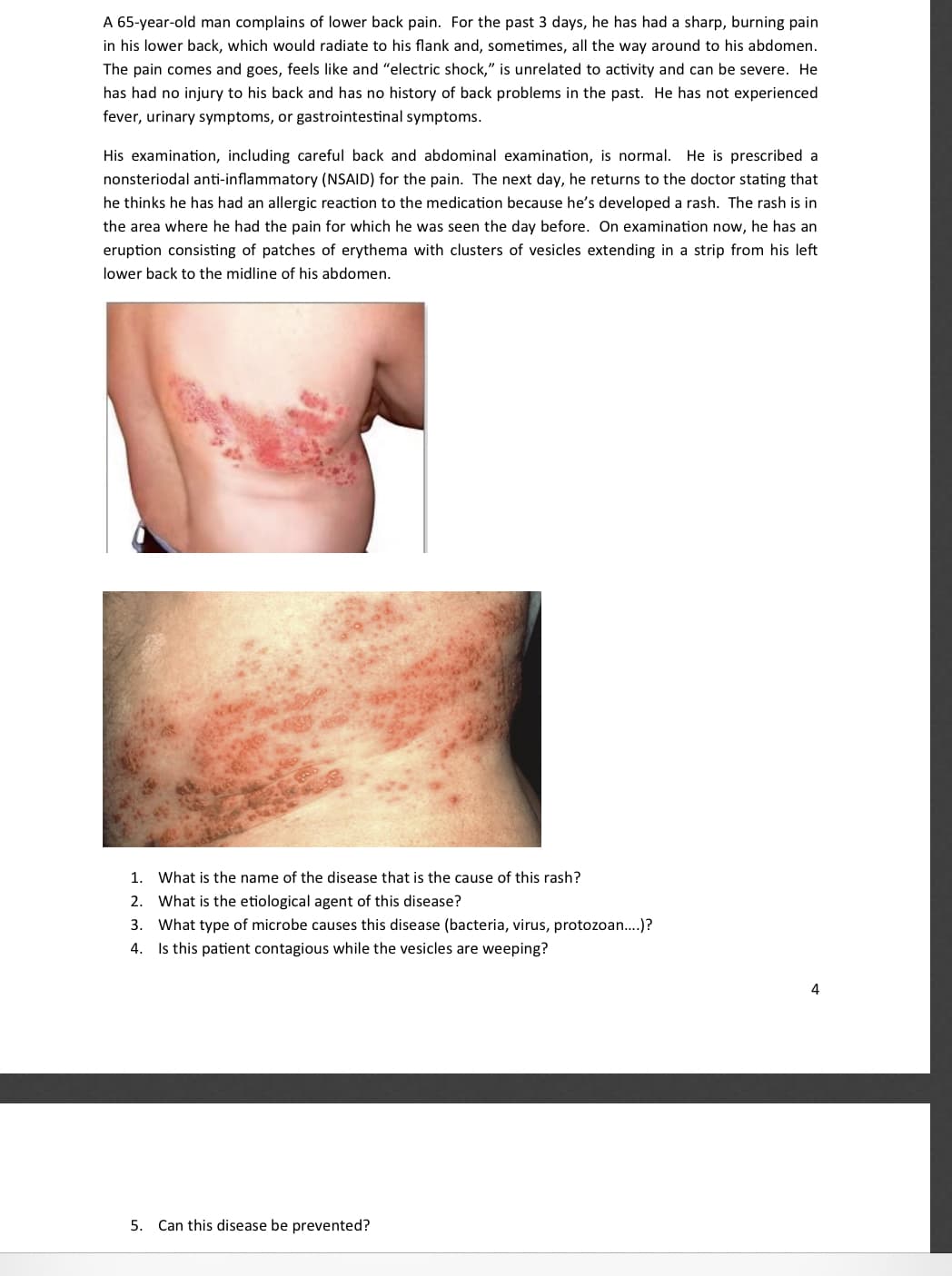A 65-year-old man complains of lower back pain. For the past 3 days, he has had a sharp, burning pain in his lower back, which would radiate to his flank and, sometimes, all the way around to his abdomen. The pain comes and goes, feels like and "electric shock," is unrelated to activity and can be severe. He has had no injury to his back and has no history of back problems in the past. He has not experienced fever, urinary symptoms, or gastrointestinal symptoms. His examination, including careful back and abdominal examination, is normal. He is prescribed a nonsteriodal anti-inflammatory (NSAID) for the pain. The next day, he returns to the doctor stating that he thinks he has had an allergic reaction to the medication because he's developed a rash. The rash is in the area where he had the pain for which he was seen the day before. On examination now, he has an eruption consisting of patches of erythema with clusters of vesicles extending in a strip from his left lower back to the midline of his abdomen. 1. What is the name of the disease that is the cause of this rash? 2. What is the etiological agent of this disease? 3. What type of microbe causes this disease (bacteria, virus, protozoan..)? 4. Is this patient contagious while the vesicles are weeping? 4
A 65-year-old man complains of lower back pain. For the past 3 days, he has had a sharp, burning pain in his lower back, which would radiate to his flank and, sometimes, all the way around to his abdomen. The pain comes and goes, feels like and "electric shock," is unrelated to activity and can be severe. He has had no injury to his back and has no history of back problems in the past. He has not experienced fever, urinary symptoms, or gastrointestinal symptoms. His examination, including careful back and abdominal examination, is normal. He is prescribed a nonsteriodal anti-inflammatory (NSAID) for the pain. The next day, he returns to the doctor stating that he thinks he has had an allergic reaction to the medication because he's developed a rash. The rash is in the area where he had the pain for which he was seen the day before. On examination now, he has an eruption consisting of patches of erythema with clusters of vesicles extending in a strip from his left lower back to the midline of his abdomen. 1. What is the name of the disease that is the cause of this rash? 2. What is the etiological agent of this disease? 3. What type of microbe causes this disease (bacteria, virus, protozoan..)? 4. Is this patient contagious while the vesicles are weeping? 4
Human Anatomy & Physiology (11th Edition)
11th Edition
ISBN:9780134580999
Author:Elaine N. Marieb, Katja N. Hoehn
Publisher:Elaine N. Marieb, Katja N. Hoehn
Chapter1: The Human Body: An Orientation
Section: Chapter Questions
Problem 1RQ: The correct sequence of levels forming the structural hierarchy is A. (a) organ, organ system,...
Related questions
Question
It's not incomplete

Transcribed Image Text:A 65-year-old man complains of lower back pain. For the past 3 days, he has had a sharp, burning pain
in his lower back, which would radiate to his flank and, sometimes, all the way around to his abdomen.
The pain comes and goes, feels like and "electric shock," is unrelated to activity and can be severe. He
has had no injury to his back and has no history of back problems in the past. He has not experienced
fever, urinary symptoms, or gastrointestinal symptoms.
His examination, including careful back and abdominal examination, is normal. He is prescribed a
nonsteriodal anti-inflammatory (NSAID) for the pain. The next day, he returns to the doctor stating that
he thinks he has had an allergic reaction to the medication because he's developed a rash. The rash is in
the area where he had the pain for which he was seen the day before. On examination now, he has an
eruption consisting of patches of erythema with clusters of vesicles extending in a strip from his left
lower back to the midline of his abdomen.
1.
What is the name of the disease that is the cause of this rash?
2. What is the etiological agent of this disease?
3. What type of microbe causes this disease (bacteria, virus, protozoan..)?
4.
Is this patient contagious while the vesicles are weeping?
4
5.
Can this disease be prevented?
Expert Solution
This question has been solved!
Explore an expertly crafted, step-by-step solution for a thorough understanding of key concepts.
This is a popular solution!
Trending now
This is a popular solution!
Step by step
Solved in 2 steps

Recommended textbooks for you

Human Anatomy & Physiology (11th Edition)
Anatomy and Physiology
ISBN:
9780134580999
Author:
Elaine N. Marieb, Katja N. Hoehn
Publisher:
PEARSON

Anatomy & Physiology
Anatomy and Physiology
ISBN:
9781259398629
Author:
McKinley, Michael P., O'loughlin, Valerie Dean, Bidle, Theresa Stouter
Publisher:
Mcgraw Hill Education,

Human Anatomy
Anatomy and Physiology
ISBN:
9780135168059
Author:
Marieb, Elaine Nicpon, Brady, Patricia, Mallatt, Jon
Publisher:
Pearson Education, Inc.,

Human Anatomy & Physiology (11th Edition)
Anatomy and Physiology
ISBN:
9780134580999
Author:
Elaine N. Marieb, Katja N. Hoehn
Publisher:
PEARSON

Anatomy & Physiology
Anatomy and Physiology
ISBN:
9781259398629
Author:
McKinley, Michael P., O'loughlin, Valerie Dean, Bidle, Theresa Stouter
Publisher:
Mcgraw Hill Education,

Human Anatomy
Anatomy and Physiology
ISBN:
9780135168059
Author:
Marieb, Elaine Nicpon, Brady, Patricia, Mallatt, Jon
Publisher:
Pearson Education, Inc.,

Anatomy & Physiology: An Integrative Approach
Anatomy and Physiology
ISBN:
9780078024283
Author:
Michael McKinley Dr., Valerie O'Loughlin, Theresa Bidle
Publisher:
McGraw-Hill Education

Human Anatomy & Physiology (Marieb, Human Anatomy…
Anatomy and Physiology
ISBN:
9780321927040
Author:
Elaine N. Marieb, Katja Hoehn
Publisher:
PEARSON